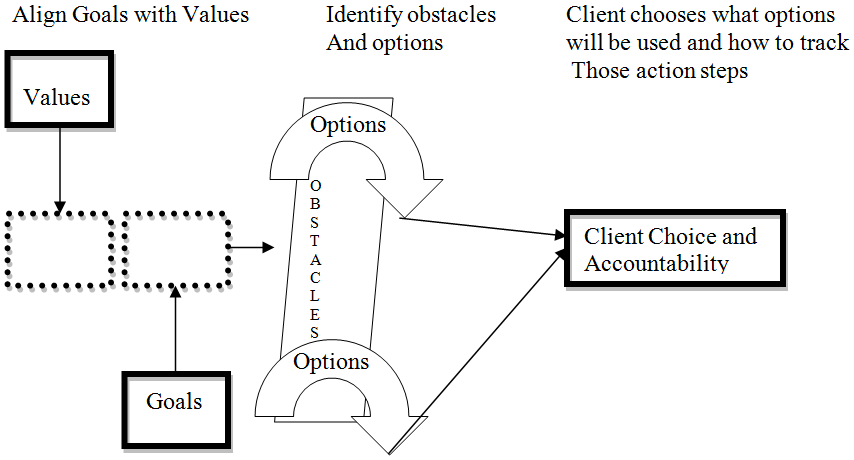A Coaching Model Created by Michael Adams
(Transition Coach, UNITED STATES)
Prior to discovering coaching I often just drifted through life accepting what came my way instead of choosing my own path. It gave a easy excuse for when things didn’t go right. When I first got into coaching, the most empowering moment was when I discovered that I had control over my choices. It was as if I had been asleep for 30 years and was just now waking up. I designed this model because I want others to experience that same awakening feeling as I help them become aware of how they too can act instead of just react their way through life.
Model Process
This model was designed to use over several sessions. It may take time for some clients to come to that sense of awareness that I hope to help them find, so the model is as follows:
Acquainted With Values
In this step I will use a variety of tools to help uncover core values within the client. The tool(s) used will depend on the learning style of the client. The ultimate intention is to get a good idea what core values the client uses so that they can be used as a measuring rod to align them with their goals
Wishful Thinking
Wishful thinking is goals that the client has without any clear idea of how to obtain those goals. Once goals and dreams are explained, we can compare them to the core values to see if any are out of alignment. If necessary, the client can then adjust goals or values to bring them into alignment.
Attention to Obstacles
At this point, it will be important to identify what obstacles are causing the goals mentioned above to be just wishful thinking instead of becoming a reality. Powerful questions will be employed to identify underlying beliefs, financial limitations, and/or physical limitations. Obstacles will be identified without attaching any judgments to them (i.e. obstacles will not be labeled as good or bad, but will simply be descriptive).
Responsibility for Action
Becoming aware of values and obstacles gives substance to what was once only a nebulous feeling. The client can now identify options that will help them start the journey toward their goals. To objective in this stage is not to identify the “right” answer, but to create a list of as many alternative courses of action as possible. Even identifying an alternative that seems like a wild idea can lead us back to the “Wishful Thinking” stage to give substance once again to the values and obstacles so that even that alternative could become a possible reality. Once a comprehensive list is completed for the options, the client can then be responsible for choosing a path that they feel will offer them the most success.
Empowerment
Empowerment is more of an end result than a step in the process. It is my hope that after taking an objective look at the reality of the situation, a client will feel a sense of ability to accomplish whatever they choose. Just being aware isn’t enough, yet it is an essential first step. Once awareness is achieved the client then has to act. On the coach’s end, empowerment will also include acknowledgement, celebration of “wins”, and encouragement to stick with it even when progress is difficult and slow.
Expectations for AWARE Model
I expect that by employing this model in my coaching practice that many will come to the realization that they are in control of their lives because they become aware of the possibilities and power within them. Too often people don’t achieve their goals because the goals just feel ethereal, distant, and impractical. Creating awareness gives substance where things were once ethereal. Awareness makes goals seem not so far away. It makes the impractical seem real and obtainable.
